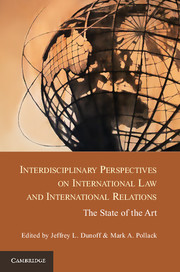 Interdisciplinary Perspectives on International Law and International Relations
Interdisciplinary Perspectives on International Law and International Relations Published online by Cambridge University Press: 05 January 2013
Over the last decade or so, a new dialogue has emerged between international relations (IR) theorists interested in the social creation of identity and who focus attention on the role of norms in international politics, and international law (IL) scholars for whom normative evolution is a stock-in-trade. These norm-interested IR thinkers have been labeled “constructivists.” Constructivists are interested in many questions, of which the social creation of norms is only one. However, because international law is, of its very nature, norm focused, it is a fascination with norm creation, evolution, and destruction that has proven to be the strongest bridging point between some IL theorists and the constructivists. This bridge will form the core of our analysis in this chapter.
Because we focus considerable attention on how international lawyers and constructivists understand and deal with norms, it is useful to specify at the outset that, in the most general terms, “norms” are standards of behavior created through mutual expectation in a social setting. Many social norms are never transformed into legal norms. Moreover, the category of “legal norm” is not fixed. What norms will be included in the category depends on one's concept of law. For legal theorists called “pluralists,” there may be no significant distinction, for example, between “law” produced by state authorities and norms created by voluntary associations: each may or may not be effective in shaping behavior. For other international lawyers, often called “positivists,” legal norms can only exist when they are produced through fixed hierarchies, usually state hierarchies. It is their formal pedigree that creates legal norms, according to positivists; therefore law exists regardless of its link to “social norms.” As we will see, other theoretical perspectives fall between these two points, or draw upon elements of each, to produce competing explanations of how international law works.
To save this book to your Kindle, first ensure [email protected] is added to your Approved Personal Document E-mail List under your Personal Document Settings on the Manage Your Content and Devices page of your Amazon account. Then enter the ‘name’ part of your Kindle email address below. Find out more about saving to your Kindle.
Note you can select to save to either the @free.kindle.com or @kindle.com variations. ‘@free.kindle.com’ emails are free but can only be saved to your device when it is connected to wi-fi. ‘@kindle.com’ emails can be delivered even when you are not connected to wi-fi, but note that service fees apply.
Find out more about the Kindle Personal Document Service.
To save content items to your account, please confirm that you agree to abide by our usage policies. If this is the first time you use this feature, you will be asked to authorise Cambridge Core to connect with your account. Find out more about saving content to Dropbox.
To save content items to your account, please confirm that you agree to abide by our usage policies. If this is the first time you use this feature, you will be asked to authorise Cambridge Core to connect with your account. Find out more about saving content to Google Drive.